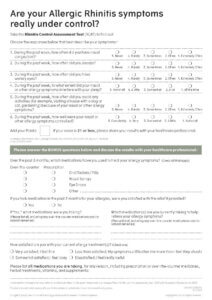Review all AR management options that may help your patients.
NOVEMBER 22, 2024
The ALK Pro Canada website is intended for Canadian healthcare professionals (HCPs) only.
Please enter your provincial licence number to confirm you are an HCP practicing in Canada.
You have selected a link that will take you to an external site. alkpro.ca provides this link as a service to website visitors. alkpro.ca is not responsible for the contents, capabilities or privacy policy of any external websites. We encourage you to read the privacy policy of every website you visit. Click ‘cancel’ to return to ALK’s site or ‘continue’ to proceed.
Vous avez sélectionné un lien qui vous mènera à un site externe. alkpro.ca fournit ce lien en tant que service aux visiteurs du site. alkpro.ca n'est pas responsable du contenu, des fonctionnalités ou de la politique de confidentialité des sites externes. Nous vous encourageons à lire la politique de confidentialité de chaque site que vous visitez. Cliquez sur « annuler » pour revenir au site d'ALK ou sur « continuer » pour poursuivre.
NOVEMBER 22, 2024
1 in 4 Canadians reported having allergies that have been diagnosed by allergy testing. The symptoms of allergic rhinitis include rhinorrhea, sneezing, and nasal itching and congestion. Although symptoms of AR may not seem like a big deal, AR can be a burden to patients in their daily life.

Tiredness, poor concentration, and reduced productivity at school or work are common in sub-optimally treated patients, compounding the burden they feel from their AR symptoms. When patients have AR, their body identifies harmless airborne allergen as being harmful and produces antibodies so that next time the individual comes into contact, the body produces chemicals (e.g., histamine) that trigger your body to produce the symptoms of AR.
Nearly 3 out of every 4 Canadians living with AR are negatively impacted by their symptoms every day during allergy season.
The good news is we are continually learning more about AR and its pathophysiology and developing different treatment approaches to better address this immunological condition.

Did you know?
AR is believed to be both underdiagnosed and undertreated.
1 in 3
More than 1 in 3 patients who sought medical care for their AR symptoms had not received a physician diagnosis.
61%
Of patients who treated their symptoms said their AR was still sub-optimally or not controlled.
About 80% of cases of AR symptoms develop before the age of 20 years. Younger patients may not have the language skills to tell you more accurate information about their symptoms.
Make sure you are investigating reports of “constant colds” and persistent rhinorrhea.
The Rhinitis Control Assessment Tool (RCAT) is a simple test that patients can take to help assess their own symptom control. The test is validated for use in patients aged 12 years or older. Patients are strongly encouraged to bring results to their healthcare professional to discuss further.
The RCAT is not intended for diagnostic purposes. It is a screener that can be used to help patients communicate their unresolved AR symptoms with their HCP.

Allergic rhinitis is commonly thought to be a disorder localized to the nose and nasal passages by patients; however, it should be recognized as an immune disorder associated with a systemic airway disease that involves the respiratory tract. Understanding the pathophysiology of AR is important to understanding treatment approaches.
The pathophysiology of AR is complex, involving both early- and late-phase allergic responses. When patients who are already sensitized to allergens – like pollen or dust mites – are exposed to these allergens, it triggers a reaction.
During the early-phase response, pre-sensitized individuals experience a rapid onset of symptoms which we commonly associate with AR (i.e., sneezing, rhinorrhea, and itchy, watery eyes). These symptoms are caused by histamine release, mostly from the nasal mucosa, which, when combined with the activity of other pro-inflammatory cytokines, also contributes to edema.
The late-phase reaction occurs hours later and involves the recruitment of various immune cells and the release of multiple inflammatory mediators, allowing the inflammatory response to continue. This, in turn, causes tissue remodeling, and further edema and nasal congestion. Tissues become “primed”, meaning the amount of allergen required to produce an immediate response is reduced with repeated allergen exposure.
Various treatment options work at different points along the pathophysiological pathway, making mechanism of action an important consideration when choosing a treatment option for your patient.
To help your patients better understand the three main
treatment approaches used in AR, download this
helpful patient information brochure.

Are you making the most of the available AR management approach? Review all AR treatment options and unlock an educational resource for your patients.
Review all AR management options that may help your patients.
Looking for more AIT information for your patients? We can help!